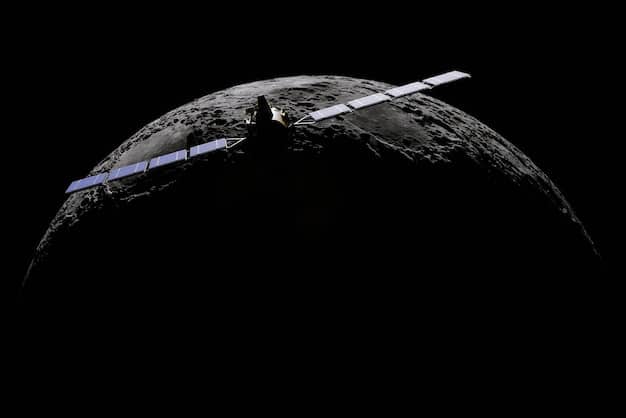US Space Force and Commercial Space: Implications Explored

The advent of the US Space Force profoundly reconfigures the commercial space industry by introducing new regulatory frameworks, enhancing research and development funding, and fostering both collaborative opportunities and competitive challenges for private enterprises operating within the increasingly critical domain of space.
The creation of the United States Space Force has undoubtedly ignited a wave of discussion across various sectors. For the burgeoning commercial space industry, understanding what are the implications of the new US Space Force for the commercial space industry is crucial for navigating future growth and operational realities. This pivotal development signals a significant shift in how space activities, both governmental and private, will be approached moving forward.
Space Force’s Mission and its Broad Strokes
The US Space Force, established in December 2019, represents the first new military service created in over 70 years. Its primary mission revolves around organizing, training, and equipping space forces to protect US and allied interests in space, provide space capabilities to the joint force, and ensure freedom of action in space. This organizational realignment underscores the growing recognition of space as a critical warfighting domain, moving beyond its traditional role as a mere support function.
Protecting Space Assets and Infrastructure
One of the core implications for commercial entities is related to the protection of space assets. As an increasing number of commercial satellites operate in various orbits, from Low Earth Orbit (LEO) to Geosynchronous Earth Orbit (GEO), they become potential targets in a contested space environment. The Space Force’s mandate includes developing capabilities to deter aggression, defend against attacks, and respond to threats in space. This protective umbrella, while primarily aimed at military assets, inherently provides a degree of security for commercial infrastructure that often shares the same orbital highways.
- Enhanced satellite security measures.
- Improved space situational awareness for all operators.
- Development of defensive counterspace capabilities.
However, this protection comes with an evolving regulatory landscape. The Space Force’s strategic objectives may lead to new guidelines for satellite operations, data handling, and even the design of commercial spacecraft to ensure compatibility with national security priorities. This could introduce additional compliance burdens but also facilitate deeper integration with government contracts and initiatives, creating new market opportunities.
Commercial Opportunities in a Militarized Space
While the term “militarized space” might evoke images of conflict, it paradoxically creates significant commercial opportunities. The Space Force’s reliance on advanced technology and rapid innovation naturally turns its gaze towards the agile and cost-effective solutions offered by the private sector. This isn’t just about procuring existing commercial products; it’s about fostering symbiotic relationships.
Demand for Commercial Services and Technology
The Space Force explicitly aims to leverage commercial capabilities to achieve its mission objectives. This includes, but isn’t limited to, satellite communication services, launch services, Earth observation data, and advanced analytics. Companies specializing in these areas are likely to see an increase in demand for their offerings as the Space Force seeks to augment its own capabilities without having to build everything in-house from scratch. This strategy aligns with a broader government trend of outsourcing non-core functions to the private sector where efficiencies can be gained.
- Increased contracts for launch services.
- New opportunities for satellite data providers.
- Growth in space-based communication and navigation services.
Furthermore, the Space Force’s sustained budget and clear long-term objectives provide a stable customer base that can de-risk private investment in ambitious space ventures. For startups and established companies alike, the prospect of securing long-term government contracts can be a powerful incentive for innovation and expansion.

Regulatory Frameworks and Compliance Challenges
The establishment of the Space Force inevitably introduces new layers of regulatory oversight and compliance. This is a critical area for commercial space companies, as the rules of engagement in space are continually being redefined. The balance between national security and commercial freedom is delicate and constantly evolving.
Navigating Export Controls and Licensing
Companies involved in developing sensitive space technologies, or those providing services to foreign entities, may encounter stricter export controls. The Space Force’s focus on maintaining technological superiority means that capabilities deemed critical for national security might face enhanced scrutiny. Similarly, licensing procedures for commercial satellite operations, especially those with dual-use capabilities (civilian and military applications), could become more complex. This necessitates a robust understanding of international trade laws and domestic regulations.
Moreover, the Space Force could influence international norms and standards for responsible behavior in space. While this could promote a more stable operating environment in the long run, it may also require commercial entities to adapt their practices to align with newly established international guidelines that reflect strategic military interests. Staying informed and proactive in anticipating these regulatory shifts will be paramount for success.
Funding and Investment Landscape Shifts
The creation of the Space Force has a quantifiable impact on the funding and investment landscape for the commercial space industry. Government spending on space-related activities is projected to increase, and a significant portion of this will inevitably flow into commercial channels. This shift offers both direct and indirect benefits to the private sector.
Direct Investment and R&D Opportunities
Beyond direct contracts for services, the Space Force is actively investing in research and development (R&D) through various programs and initiatives. This often takes the form of grants, cooperative agreements, and partnerships with private companies and academic institutions. Areas of particular interest include advanced propulsion systems, resilient satellite architectures, space-based sensing, and cyber security for space systems. Companies that can align their innovation efforts with these strategic priorities stand to gain significant R&D funding, accelerating their technological development without bearing the full financial burden.
- Increased government R&D grants for commercial firms.
- Partnerships for developing next-generation space technologies.
- Stimulation of private investment through government commitment.
This government investment can also act as a catalyst for private venture capital. When a clear, large-scale customer like the Space Force signals its commitment to certain technologies or services, it significantly reduces the perceived risk for private investors, encouraging more capital to flow into the space sector as a whole. This creates a virtuous cycle of innovation and investment.
Data and Information Sharing Paradigms
The Space Force’s mission relies heavily on superior space situational awareness (SSA) and intelligence. This often requires the aggregation and analysis of vast amounts of data from various sources, including commercial satellite operators. The implications for data sharing and information exchange are profound, shaping future collaboration models.
Collaboration on Space Situational Awareness
Commercial operators possess unique data sets and observational capabilities that can significantly enhance the Space Force’s understanding of the space environment. This opens avenues for collaboration where commercial companies could provide their data or analytical services to the government. Such partnerships would require robust data-sharing agreements and clear protocols to protect proprietary information while contributing to national security. The potential for a more comprehensive and shared picture of space activity could benefit all users, reducing collision risks and enhancing overall space safety.
Conversely, the Space Force might also share its own SSA data with commercial entities, particularly information related to potential threats or conjunction risks, provided it does not compromise classified information. This bi-directional flow of information, though complex to implement, is essential for fostering a more secure and predictable space environment for all stakeholders, both government and commercial. Developing secure and efficient data exchange platforms will be a key challenge and opportunity.

Competition and Market Dynamics Evolution
While opportunities abound, the rise of the Space Force also introduces new competitive dynamics into the commercial space industry. The government’s increased emphasis on space as a strategic domain means that some areas previously dominated by commercial innovation might now see direct or indirect military involvement, potentially altering market structures.
Government as a Competitor or Collaborator?
In certain niche areas, the Space Force might develop specialized capabilities in-house that could be perceived as competing with commercial offerings. This is less likely for commodity services but could occur for highly sensitive or novel technologies. The more common scenario, however, is likely to be one of collaboration, where the Space Force acts as a primary customer and enabler rather than a direct competitor. The challenge for commercial companies will be to identify and leverage their unique value propositions that complement, rather than duplicate, government capabilities.
Moreover, the substantial government investment in space infrastructure and technology can inadvertently raise the barrier to entry for smaller commercial players. Companies that can demonstrate a clear alignment with national security objectives, or those that can offer cutting-edge solutions at competitive prices, are more likely to thrive in this evolving environment. The market will undoubtedly become more sophisticated, demanding greater technological maturity and operational resilience from commercial entities.
| Key Implication | Brief Description |
|---|---|
| 🛡️ Enhanced Security | Commercial assets benefit from increased space domain awareness and protection efforts. |
| 📈 Market Expansion | Increased demand for commercial services (launch, comms, data) and R&D partnerships. |
| ⚖️ Regulatory Shifts | Evolving export controls and licensing requirements necessitate careful compliance. |
| 🤝 Data Collaboration | Opportunities for commercial data to enhance Space Force’s situational awareness. |
Frequently Asked Questions
▼
The Space Force acts as a significant customer for commercial launch services, leading to increased demand and investment in that sector. This ensures a stable operational environment while potentially fostering innovation by requiring more competitive and reliable launch solutions from private providers.
▼
Yes, it’s highly probable. The Space Force’s focus on national security in space may lead to new or updated regulations impacting satellite operations, data security, and export controls for advanced space technologies. Commercial firms will need to adapt to these evolving compliance requirements.
▼
Absolutely. The Space Force actively seeks to leverage private sector innovation. They offer various funding opportunities, including grants, contracts, and partnership agreements, particularly for technologies that align with their strategic priorities like enhanced space situational awareness, resilient communications, and advanced propulsion systems.
▼
Generally, no. The Space Force largely aims to be a customer and enabler for commercial space rather than a direct competitor. While some in-house capabilities may be developed, the broader strategy is to leverage the agility and innovation of the private sector to meet national security needs effectively.
▼
Collaboration can occur through various channels, including responding to requests for proposals (RFPs), participating in R&D initiatives, offering commercial services, and engaging in data-sharing agreements. Networking at industry events and understanding Space Force’s strategic objectives are also crucial steps for potential partners.
Conclusion
The establishment of the US Space Force marks a pivotal moment, fundamentally reshaping the commercial space industry. Far from being a prohibitive force, it presents a dynamic landscape of both significant opportunities and complex challenges. Commercial companies are now faced with an increasingly secure, yet highly regulated, operating environment. The Space Force’s demand for innovative solutions and its substantial R&D investments will undoubtedly stimulate growth, fostering new markets for launch services, satellite operations, data analytics, and advanced space technologies. Navigating the evolving regulatory frameworks and understanding the nuances of government procurement will be key for success. Ultimately, the synergistic relationship between the US Space Force and the commercial space industry is set to drive unprecedented advancements, pushing the boundaries of what is possible in the final frontier while ensuring national security in this critical domain.





